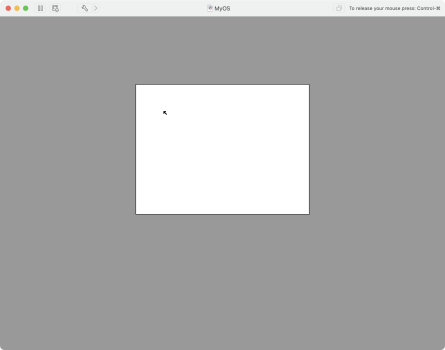This is an extremely niche question so I fully appreciate that I may not get an answer here... I'm just too lazy to sign up to a more appropriate forum if I don't have to 
In an effort to learn a bit more about how modern computers work, I've had a bit of a play around and have created a "Hello World OS" that, so far, does nothing but say "hello world" and then loop infinitely. With the docs over at https://wiki.osdev.org/UEFI#Creating_disk_images I've used hdiutil to produce a .cdr image containing my bootx64.efi file:
The resulting image works in QEMU, but that's a bit too fiddly for my taste so I'm trying to use it in VMware. However, I'm getting stuck. When I start up the VM, I get the following:
I'm not sure why it's reporting no media in the CD drive, because the image is definitely mounted. If I boot into the EFI Shell and run "map" then it only shows blk0 and blk1; fs0 isn't mapped.
There's presumably something wrong with the image; it seems that QEMU can tolerate it but VMware doesn't like it. I can double-click it in Finder and it mounts successfully and I can see the directory structure and bootx64.efi file. It's probably something subtle.
If I mount a different ISO file (such as a Linux distribution) then fs0 shows up inside the EFI Shell, so I'm pretty sure that the issue is with the image creation process itself.
So my question is "does anyone know how to make an image that VMware is happy with?"
In an effort to learn a bit more about how modern computers work, I've had a bit of a play around and have created a "Hello World OS" that, so far, does nothing but say "hello world" and then loop infinitely. With the docs over at https://wiki.osdev.org/UEFI#Creating_disk_images I've used hdiutil to produce a .cdr image containing my bootx64.efi file:
Code:
hdiutil create -fs fat32 -ov -size 48m -volname NEWOS -format UDTO -srcfolder diskImage uefi.cdrThe resulting image works in QEMU, but that's a bit too fiddly for my taste so I'm trying to use it in VMware. However, I'm getting stuck. When I start up the VM, I get the following:
Code:
Attempting to start up from:
-> EFI VMware Virtual IDE Hard Drive (IDE 0:0)... No Media.
-> EFI VMware Virtual IDE CDROM Drive (IDE 1:0)... No Media.
-> EFI Network...I'm not sure why it's reporting no media in the CD drive, because the image is definitely mounted. If I boot into the EFI Shell and run "map" then it only shows blk0 and blk1; fs0 isn't mapped.
There's presumably something wrong with the image; it seems that QEMU can tolerate it but VMware doesn't like it. I can double-click it in Finder and it mounts successfully and I can see the directory structure and bootx64.efi file. It's probably something subtle.
If I mount a different ISO file (such as a Linux distribution) then fs0 shows up inside the EFI Shell, so I'm pretty sure that the issue is with the image creation process itself.
So my question is "does anyone know how to make an image that VMware is happy with?"


